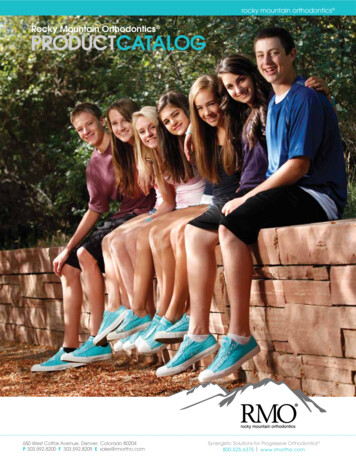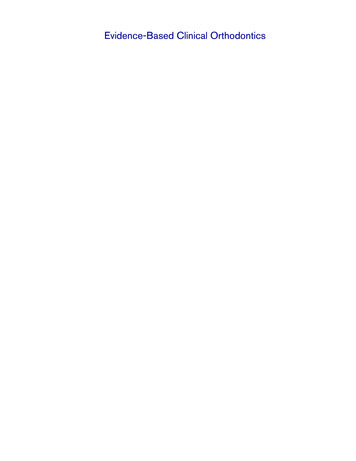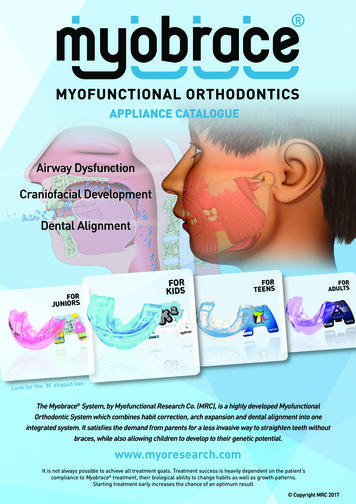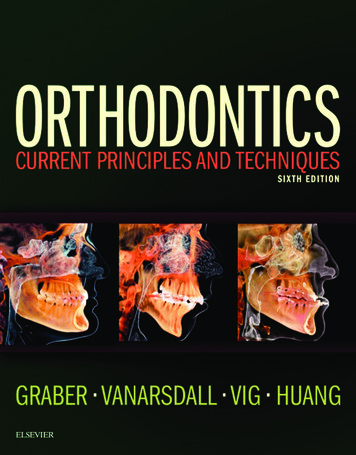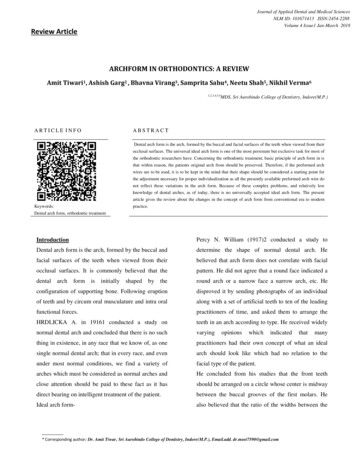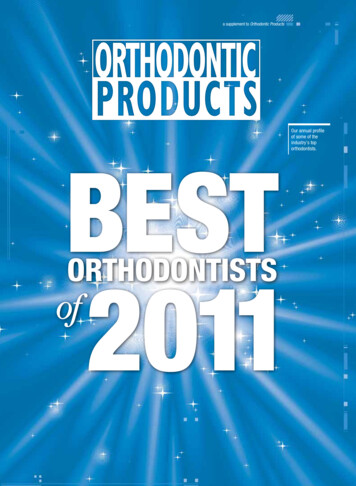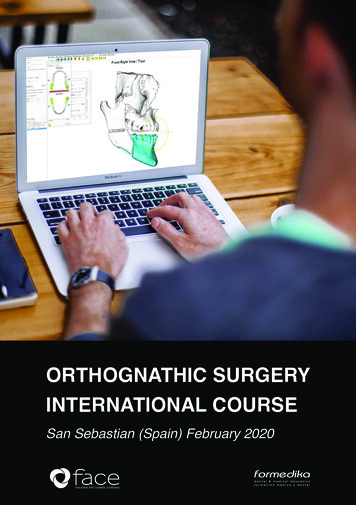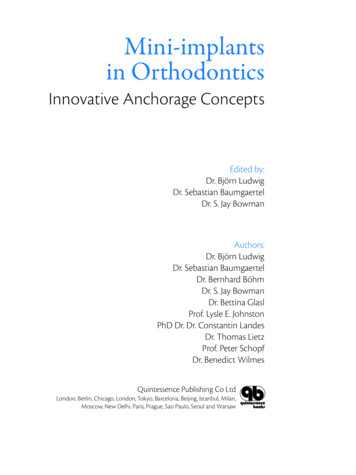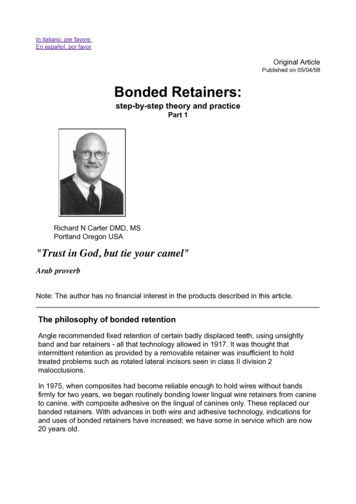
Transcription
In italiano, per favoreEn español, por favorOriginal ArticlePublished on 05/04/98Bonded Retainers:step-by-step theory and practicePart 1Richard N Carter DMD, MSPortland Oregon USA"Trust in God, but tie your camel"Arab proverbNote: The author has no financial interest in the products described in this article.The philosophy of bonded retentionAngle recommended fixed retention of certain badly displaced teeth, using unsightlyband and bar retainers - all that technology allowed in 1917. It was thought thatintermittent retention as provided by a removable retainer was insufficient to holdtreated problems such as rotated lateral incisors seen in class II division 2malocclusions.In 1975, when composites had become reliable enough to hold wires without bandsfirmly for two years, we began routinely bonding lower lingual wire retainers from canineto canine, with composite adhesive on the lingual of canines only. These replaced ourbanded retainers. With advances in both wire and adhesive technology, indications forand uses of bonded retainers have increased; we have some in service which are now20 years old.
When occlusion and crown length permit,virtually any pair or set of teeth within asingle arch can be bonded from the lingualor palatal. Such cosmetic and functionalretention has removed much of theimprecision and most cooperationrequirements from routine orthodonticretention. It allows us to offer extendedretention plans to most of our patientsfollowing a normal two year retention2Figure 1. A bonded lower lingualcanine-to-canine retainer does morethan just hold the lower anterior teeth.Notice the role of overbite and overjet inmaintaining form and function.Pressure of the lower lip restingnormally against the upper incisaledges creates a force holding uppersagainst lowers against a smooth lingualarch.period . Such retainers give excellentservice for ten or more years withoutreplacement. They require little patientcooperation. They provide constant andrelatively fixed retention.Lower bonded lingual retainersFigure 1 shows a lateral view of a bondedlower retainer. Lip pressure of the lower lipagainst the incisal edges of the upperincisors holds the upper teeth against thelowers, which are held against the smoothbonded retainer wire. The lingual wire is partof a fixed system which holds the canines,the intercanine width, and the anterior archform - both lower and upper - in the exactposition of the arch at the time of bracketremoval. It does not hold the incisor teethvertically, depending instead on excellentanterior coupling to hold relationshipsthrough normal function. Usually, lowerbonded retainers are from canine-to-canineand only bonded to the canine teeth with filled posterior composite resin (P50 , 3M).This is important.Teeth must be relatively free to moveindependently with function. If adjacent teethare held tightly together -e.g., directlybonding two centrals together - there willoften be a fracture of the common bond dueto independent flexion of the periodontalligaments. Also, bonded 3 to 3 retainersshould not be used where anterior couplingis not ideal, because the lack of physiologicforces shown in Figure 1 will render suchretainers inadequate. They should not beused if the teeth are not straight! Prior to
scheduling bracket removal and taking theretainer impression, all contact points shouldbe flattened and "reproximated" to resist3,4displacement and all spaces closed. Theretainer wire is constructed to idealalignment.Upper (palatal) bonded wire retainersFigure 2. Rotations are distinguishedfrom crowding, because the freegingival fibers have a memory of therotation and are not reorganized duringorthodontic tooth movement. We havefiberotomies performed during activetreatment after teeth are derotated to a110 % (overcorrected) position, thenhold these teeth with flexible bondedretainers for two or more years.A belt and suspenders ?Because the lower incisors normally occludein the lingual fossae of the upper, space tobond retainers is limited, especially inchildren with short crown heights. Indicationsfor bonded upper linguals are:Rotated teethDiastemasRotations are different from simple crowding.(Figure 2.) They should be held firmly for two4,5, 6,7years after active treatment. Inaddition, we have free gingival fiberotomies,8as described by Edwards , performed by anoral surgeon or periodontist at least sixmonths before brackets are removed to helpprevent the pull of the free gingival fibersfrom creating rotational relapse. We hold therotations and still allow the periodontalligaments to function when holding adjacent teeth by using flexible spiral wires (FSWMasel) as the retainer.Various authors have described methods of9,10, 11,12bonding retainersand we haveborrowed freely from them and incorporatedrefinements FSW retainers are bonded toeach tooth they rest on, after sealing theentire lingual surface with light cured 3M Scotchbond resin.Care is taken to keep the composite smooth,minimal, and out of occlusion. In effect, weare enlarging the cinguli of the maxillaryincisors in most cases (Figure 3).
Figure 3. A bonded upper retainer wireis located in the gingival third of thetooth to avoid occlusion. The compositeis smoothed to effectively enlarge thecingulum slightly, feathering the edge soplaque retention is minimized.Lower bonded retainer preparationand fabricationAn impression of the linguals of teeth to beretained is taken at the appointmentpreceding bracket removal. Beading wax isrolled to the thickness of thin spaghetti and arope pushed under the gingival wings of theFigure 4. A. Impressions are made with anterior brackets to prevent alginate tearingappliances in place, so the retainer may when the impression is removed.Usually, one scoop of alginate placed in thebe bonded at the day of bracketanterior only in a medium tray will giveremoval.excellent coverage of the six anteriors.Figure 4. B. Models are trimmed up tothe last tooth to be bonded to facilitatewire bending.A model is poured and trimmed to the firstteeth to be bonded, so that access is easyfor wire bending (Figure 4). Pre-formed .030stainless steel wire segments (Figure 5) aremade by assistants during slack time bybending around a turret.Lingual wire main segments should not bebent with pliers, which will give asymmetricand marked wires. Remember, the arch formis supposed to be even and ideal - if there isa slight irregularity it should not be heldpermanently by bending the arch to contactit. We send these to a supplier for goldplating (WonderWire, Wyomissing PA USA).Because canines are thicker than incisors,the wire ends have a slight bend to allow theloop to rest in the middle of the canine whilethe perfectly smooth anterior segmenttouches the lingual surface of all incisors.Notice that the wire must rest at theincisal/middle third junction of the crowns, atthe contact points (Figure 6).Mistakenly placing the wire in the middle orlower third of the teeth will allow incisors toslip and crowd. The ends of the wire may bebent at right angles or loops for added
retention. (Figure 6). Note that the loopsmust tip toward the gingival to follow thecontour of the canines.The portions to be bonded are roughenedwith a heatless stone to increase adhesion.In contrast to Zachrisson, we have not foundit necessary to sandblast, but have alwaysroughened the ends.Click here for Part 2HOME VJO 2.2HOME VJOVirtual Journal of OrthodonticsCopyright 1998 All rights reserved.Figure 5. Preformed .030 stainlesssteel wire segments are bent byassistants -into ideal arch form- andstored.Avoid bending the incisor segment withpliers to avoid nicks or dents orasymmetries. By bending aroundturrets, symmetry is maintained.
Masel) as the retainer. Various authors have described methods of bonding retainers 9,10, 11,12 and we have borrowed freely from them and incorporated refinements FSW retainers are bonded to each tooth they rest on, after sealing the entire lingual surface with light cured 3M Scotchbond resin. Care is taken to keep the composite smooth, minimal, and out of occlusion. In effect, we are .
